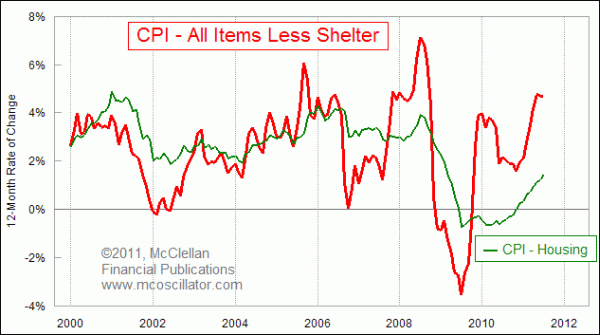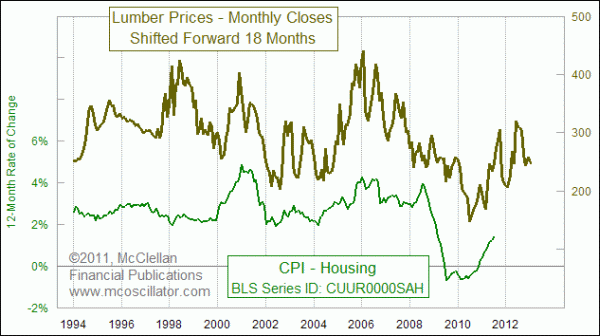By Tom McClellan
I’ll bet you did not know that housing
makes up 42% of the Consumer Price Index (CPI). All the rest of it, food,
energy, clothing, recreation, education, transportation, toys, cosmetics, etc.
makes up the other 58%. So whatever housing prices are doing has a big effect
on the headline CPI number.
The softness of housing prices continues to
artificially supress the growth of the CPI inflation rate. Some Fed officials are even saying that they
need to strive for higher inflation to help the economy rebound, in spite of
the Fed’s mandate to promote “stable prices”.
Most people have heard about the CPI
variant that excludes food and energy. But not many people outside the
economics community know that the Bureau of Labor Statistics also publishes a
long list of alternate permutations of CPI calculations, including or excluding
various components. This week’s chart shows a comparison of the CPI-Housing
growth rate versus “all items less shelter”, which is that other 58% of the CPI
calculation I mentioned above. When we exclude the contribution of the housing
price data, we can see that the inflation rate for everything else is already up
to 4.68%.

And this high inflation rate is occurring
at a time when the yield on the 30-year T-Bond is just 3.51%, and 10-year
T-Notes are yielding just 2.15%!
The chart also reveals that the CPI-Housing
growth rate is already working on catching up to where the inflation rate has
gone for everything else. And if the next chart is correct, the future should
bring even higher housing costs.

This chart shows that the CPI-Housing
growth rate follows the movements of lumber prices, with a lag time of about 18
months. So the bottom for housing prices in 2010 was just the echo of the
bottom in lumber prices in early 2009. The current uptrend for the growth rate
of CPI-Housing is following the path of an up move in lumber prices that
occurred 18 months before. Lumber prices peaked in December 2010, which
suggests that the CPI-Housing numbers should continue rising until around June
2012.
If so, that is going to take away the
depressing effects of low housing prices on the headline CPI data. And a higher
input from housing prices joining with the already 4%+ inflation everywhere else
is going to make it really hard for the Fed to live up to its promise to keep
interest rates low until 2013.
No comments:
Post a Comment